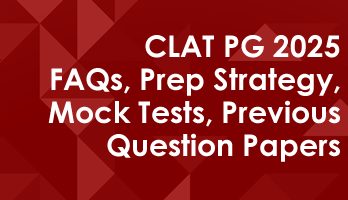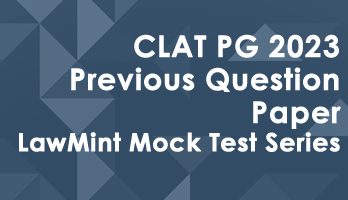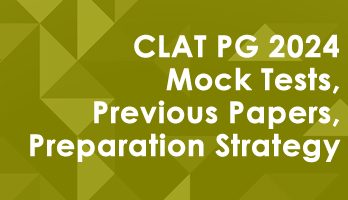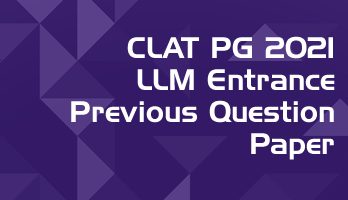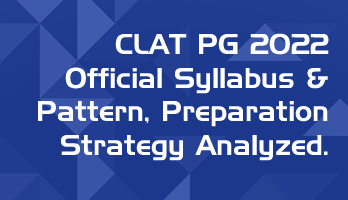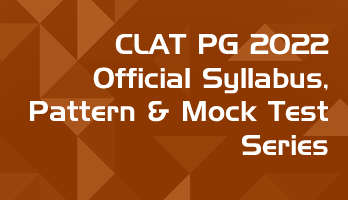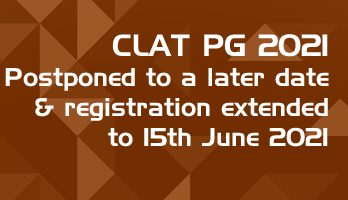- Updated as per latest CLAT PG pattern
- Overall there are 300+ comprehension passages - with 2350+ questions
- 100 passages are provided as stand-alone mini mock tests
- 120 passages are combined to form 10 full-length mock tests
- 2020, 2021, 2022, 2023 and 2024 (New Pattern) Question papers included as mock tests
- Answers include the reason or 'rationale' for better understanding
- Order of the questions and answer choices are shuffled in every attempt for better practice
- The passages are of various lengths and complexities for better practice
- Unlimited access & practice - valid for one year from date of purchase
- Accessible 24 x 7 via Smart-Phone browsers and Desktops
- More the 100 LawMint users were selected by various top NLUs in 2020, 2021, 2022 and 2023 - Including NLSIU, NALSAR, NLU-J, WBNUJS
- Our users were also selected for the IIT KGP LLM, NLU Delhi (AILET PG) & DU LLM programs
Also included in the pack : (Useful for non-CLAT LLM entrance exams) :
- 11 CLAT PG old pattern previous Papers - 2009 to 2019 (as mock tests)
- 50 full-length old MCQ format mock tests (100 questions each)
- 50 old pattern MCQ mini-mock tests (25 questions each)
- Summarized overview of Important Jurisprudence topics (For Subjective & Objective questions)
- Overview of all Constitutional Amendments
- All Tests & Previous Papers are timed and have Negative marking for realistic simulation
- Questions & Answer Choices randomly shuffled in every attempt for better practice
Authentic Feedback from previous LawMint users :
I got AIR 21 in CLAT PG. Thank you so much. Your mocks helped me a lot in my preparation 🙂 - Ayushi Jain
I have subscribed to your CLAT PG program and got AIR 36 in this year CLAT PG. I have also secured AIR 54 in AILET PG exam. I would like to thank you. Your mock paper really helps a lot - Shrashank Tripathi
I would like to thank you for the CLAT PG LLM COURSE. Practising mock tests there helped me in getting confidence and hence I was able to get AIR 45 in CLAT PG LLM - Akshay Awasthi
A year back, I relied on the IIT Kharagpur RGSOIPL mock test series by LawMint to prepare for my RGSOIPL entrance test. Few months back, I relied on your UGC NET Law series to prepare for UGC NET. I was the topper of the RGSOIPL entrance, and have cracked JRF in UGC NET. All thanks to LawMint - Anshuman Sahoo
"I got AIR 18 in CLAT PG and General Category rank 28 in AILET PG. I want to thank you for helping me practice well in controlled conditions from any place. It gave me a lot of confidence and I took the tests while travelling too. I also made it to IIT Kharagpur." - Vinodharani
"Lawmint has been of great help to me in securing AIR 25 in AILET PG and AIR 29 in CLAT PG examinations. The subjective and objective approach of the test series kept me up to date with the latest exam pattern." - Bhawna Nanda
"I, Nimmy Saira Zachariah joined you clat test series. I cleared AILET PG with 30th rank. Your test series were of immense help as it gave me clear idea of where my preparations stand thank you once again law mint." - Nimmy S Z
"Hey guys. Where do I start? If I thought that getting AIR 59 in Clat PG was it, then how wrong I was. With Lawmint now I have cracked UGC NET as well." - Joyanta Chakraborty
Important : The question paper pattern has changed for the year 2020. The new pattern will consist of comprehension based questions. i.e. MCQs based on passages about various legal topics. In the LawMint Mock Tests, we have provided many different practice passages for extensive practice.
This is the full previous question paper from the CLAT LLM 2019 i.e. the CLAT PG 2019 examination conducted for admissions into the LLM programs across all the National Law Universities (NLU’s) across India, except NLU-Delhi.
The question paper consists of two parts – the objective part ‘A’ consisting of 100 multiple choice questions; and the subjective part ‘B’ for 50 marks.
The answer key for this question paper, along with other CLAT PG LLM previous papers is included in our online practice pack.
CLAT LLM 2019 – Objective Part
1. Which one of the following is not formally considered as an amendment to the Constitution under Article 368?
(A) Creation of new states
(B) Change in the Preamble
(C) Change in the Part IV A
(D) Change in Part XII
2. Who presides over the joint sitting of the two Houses of Parliament?
(A) Speaker
(B) President
(C) Vice President
(D) Nominee of the Chief Justice of India.
3. Which of the following category of judges is not mentioned in the Constitution?
(A) Acting Judge.
(B) Additional Judge
(C) Adhoc Judge
(D) Puisne Judge
4. The right to vote in elections in India is a:
(A) Fundamental right
(B) Constitutional right
(C) Statutory right
(D) Customary right
5. The fundamental right to form co-operative societies is provided under:
(A) Article 19 (1) (C)
(B) Article 21
(C) Article 14
(D) Article 51 A (j)
6. The Ordinance making power of the President under the Indian Constitution is:
(A) An Executive power
(B) A legislative power
(C) Quasi-legislative power
(D) Quasi executive power
7. The concurrent power to impose tax has been provided under:
(A) Article 246
(B) List III of Schedule VII
(C) Article 307
(D) Article 246 A
8. The Goods and Services Tax Council is set up under :
(A) Article 263
(B) Article 269-A
(C) Article 279-A
(D) Article 281
9. Who was the Constitutional Advisor to the Constituent Assembly?
(A) B N Rau
(B) B R Ambedkar
(C) Rajendra Prasad
(D) K M Munshi
10. Which one of the following is the correct statement in relation to the Collegium?
(A) Appointment and transfer of judges in the higher judiciary
(B) Appointment and transfer of judges in the judiciary
(C) Appointment, transfer and removal of judges in the judiciary
(D) Appointment, transfer, recusal and removal of judges in the judiciary
11. The Vice – President of India can be removed from office by:
(A) Impeachment.
(B) Resolution passed by both Houses of Parliament.
(C) Resolution passed by the Council of States and agreed to by the House of the People.
(D) Resolution by both Houses and Order signed by the President of India.
12. The President decides on disqualification of Members of Parliament under Article 103 only on the advice of:
(A) Council of Ministers
(B) Constitution Bench of the Supreme Court of India
(C) Election Commission
(D) Chief Justice of India.
13. The recent amendment to the Constitution of India paving way for 10% reservation for Economically Weaker sections was done by amending:
(A) Article 14
(B) Articles 15 and 16
(C) Article 15
(D) Article 338
14. How many amendments have been made to the Indian Constitution so far?
(A) 102
(B) 121
(C) 103
(D) 126
15. The National Commission for Backward Classes was created by:
(A) The Constitution (One Hundred and First Amendment) Act, 2016
(B) The Constitution (One Hundred and Second Amendment) Act, 2018
(C) The Constitution (One Hundred and Third Amendment) Act, 2019
(D) The Constitution (One Hundredth Amendment) Act, 2015
16. Which among the following States has no Legislative Council?
(A) Andhra Pradesh
(B) Telangana
(C) Bihar
(D) Madhya Pradesh
17. Passive euthanasia under certain circumstance is permissible was upheld in the case of:
(A) Aruna Ramachandra Shanbaug v. Union of India
(B) Gian Kaur v. State of Punjab
(C) State of Maharashtra v. Maruty Sripaty Dubal
(D) P. Rathinam v. Union of India
18. Compensatory jurisprudence was invoked by the Supreme Court in:
(A) Keshavanada Bharathi v. State of Kerala
(B) Rudal Shah v. State of Bihar
(C) Indira Nehru Gandhi v. Rajnarain
(D) Kihota Hollohan v. Zachilhu
19. Basheshar Nath v. Commissioner of Income Tax, is often quoted with reference to the:
(A) Doctrine of Eclipse
(B) Doctrine of severability
(C) Doctrine of Waiver of Fundamental Rights
(D) Doctrine of territorial nexus
20. Gunupati v. Nafizul Hasan deals with:
(A) Presidents’ election
(B) Privileges of the legislature
(C) Pardoning power
(D) Office of profit
21. Reservation in promotions with consequential seniority in favour of Scheduled Castes and Scheduled Tribes is facilitated by:
(A) Art. 16 (4A)
(B) Art. 16(3)
(C) Art. 16 (4B)
(D) Art. 15 (3)
22. Art. 141 of the Indian Constitution provides:
(A) Law declared by it is not binding on High Courts
(B) Law declared by the Supreme Court shall be binding on all courts within the territory of India
(C) Advisory opinion may be given
(D) Appeals from the High Court
23. Doctrine of legitimate expectation and wednesbury principles were read by Supreme Court into:
(A) Art. 12
(B) Art.14
(C) Art. 23
(D) Art.22
24. A seven member bench of the Supreme Court unanimously struck down clauses 2(d) of Art.323 A and Clause 3(d) of Art 323B of the Constitution relating to tribunals which excluded the jurisdiction of High Court and Supreme Court. The court held that power of judicial review over legislative action is vested in the High Court under Art.226 and in the Supreme Court under Art.32. This is an integral part of the basic structure of the constitution. Name the case:
(A) L. Chandra Kumar v. Union of India
(B) KihotaHollohon v. Zachilhu
(C) Nagaraj v. State of A.P.
(D) Rajendra Singh Rana v. Swami Prasad Maurya
25. The phrase ‘complete justice’ is used in:
(A) Article 141
(B) Article 142
(C) Article 144
(D) Article 145
26. The minimum number of judges of the Supreme Court who are to sit to decide any case involving a substantial question of law as to the interpretation of the Constitution shall be:
(A) Three
(B) Five
(C) Seven
(D) Nine
27. Which of the following duties was inserted by way of an amendment in 2002?
(A) To uphold and protect the sovereignty, unity and integrity of India.
(B) To value and preserve the rich heritage of our composite culture
(C) To safeguard public property and abjure violence
(D) Who is a parent or guardian to provide opportunities for education to his child or, as the case may be, ward between the age of six and fourteen years.
28. The Parliament of India consists of:
(A) Two Houses of Parliament
(B) President and Two Houses of Parliament
(C) President, Prime Minister and two Houses of Parliament
(D) President, Vice President and two Houses of Parliament.
29. The Goods and Services Tax Council shall make recommendations to the Union and the States on a number of issues. Special provisions to how many States the Council can make recommendations?
(A) Six
(B) Eight
(C) Eleven
(D) Thirteen
30. How many High Courts are there in India?
(A) 21
(B) 22
(C) 23
(D) 24
31. What is the total strength of the Supreme Court including the Chief Justice of India?
(A) 27
(B) 29
(C) 31
(D) 32
32. In which case the doctrine of severability was extended by the Supreme Court to constitutional amendments?
(A) A.K. Gopalan v. State of Madras
(B) Golaknath v. State of Punjab
(C) Keshavananda Bharati v. State of Kerala
(D) Kihota Hollahan v. Zachilhu
33. Among the following judges, against whom the motion for removal were initiated in either House of Parliament?
(A) Justice Ramaswamy and Justice Dinakaran
(B) Justice Ramaswamy and Justice Soumitro Sen
(C) Justice Dinakaran and Justice Soumitro Sen
(D) Justice Ramaswamy and Justice Karnan
34. Recently, the Supreme Court in Ram-Janmabhumi case:
(A) Has ordered mediation by a panel
(B) Has declined to decide on the case
(C) Has upheld the Allahabad High Court’s decision
(D) None of the above
35. The Constitution Day is celebrated on:
(A) 26th January
(B) 15th August
(C) 26th November
(D) 10th December
36. If the Anglo-Indian Community is adequately represented, the President may nominate not more than __________ members to the Lok Sabha:
(A) Three
(B) Two
(C) One
(D) Four
37. In which case the Supreme Court applied the doctrine of Prospective Over-ruling for the first time to resolve a constitutional question?
(A) A. K. Gopalan v. State of Madras
(B) Sajjan Singh v. State of Rajasthan
(C) Shakari Prasad v. Union of India
(D) Golaknath v. State of Punjab
38. How many judges of the Supreme Court were superseded in the appointment of Justice A.N. Ray as the Chief Justice of India?
(A) One
(B) Three
(C) Two
(D) None
39. The Directive Principles of State Policy were framed based on the provisions of:
(A) Swiss Constitution
(B) Australian Constitution
(C) Irish Constitution
(D) None
40. The Chief Justice of India who passed away while in office was:
(A) Justice A.N. Ray
(B) Justice Sabayasachi Mukharji
(C) Justice J.S. Verma
(D) Justice E.S. Venkataramiah
41. Every promise and every set of promises, forming the consideration for each other is known as
(A) Consideration
(B) Agreement
(C) Contract
(D) Reciprocal Promises
42. The correct sequence in the formation of a contract is
(A) Offer, acceptance, agreement, consideration
(B) Agreement, consideration, offer, acceptance
(C) Offer, consideration, acceptance, agreement,
(D) Offer, acceptance, consideration, agreement
43. Match List-I with List-II and select the correct answer using the codes given below the lists:
List-I List-II
(a) Mohiri Bibi Case 1. Remoteness of damage
(b) Satyabrata Ghose Case 2. Frustration of Contract
(c) Hadley v. Baxendale 3. Invitation to treat
(d) Carlill v. Carbolic 4. Minor’s contract
Codes : (a) (b) (c) (d)
(A) 4 2 1 3
(B) 2 3 1 4
(C) 4 1 2 3
(D) 1 2 3 4
44. Acceptance sent through post:
(A) can be revoked at any time
(B) cannot be revoked at all
(C) can be revoked before it comes to the knowledge of the offeror
(D) can be revoked only if it does not reach the offeror
45. ‘A’ applied for allotment of 100 shares in ‘B’ company. A letter of allotment addressed to ‘A’ was posted in due time, but it never reached ‘A’. The posting of letter of allotment:
(A) completes the contract
(B) does not completes the contract
(C) makes the contract voidable
(D) makes the contract void
46. A takes a life insurance policy making a false statement about his health and does not disclose the fact that he has been treated for a serious illness. In this case which one of the following statements is correct:
(A) The Contract is void
(B) The Contract is valid
(C) Contract is voidable on the ground of fraud
(D) Contract is voidable on the ground of misrepresentation
47. In which case it has been laid down that a promise to pay subscription is binding on the promisor if promisee has undertaken some liability on the faith of the promisee:
(A) Lalman Shukla v. Gauri Dutt
(B) Kedar Nath v. Gorie Mohd
(C) Bhagwandas v. Girdhari Lal
(D) Banwari Lal v. Sukhdarshan Dayal
48. Is past consideration for a promise valid to create a contract?
(A) It is valid only in Indian Law and not in English Law
(B) It is valid only in English Law and not in Indian Law
(C) It is valid both in Indian Law and English Law
(D) It is neither valid in English Law nor in Indian Law
49. An agreement not enforceable by law is:
(A) Void
(B) Contract
(C) Voidable Contract
(D) Valid Contract
50. Where the relations subsisting between the parties are such that one of the parties is in a position to dominate the will of the other and uses that position to obtain an unfair advantage over the other is known as
(A) Coercion
(B) Misrepresentation
(C) Fraud
(D) Undue Influence
51. The maxim actio personalis moritur cum persona means:
(A) Personal action dies with the parties to the cause of action
(B) An action is not given to him who has received no damages
(C) No one is responsible for inevitable accidents
(D) An act done by me against my will, is not my act
52. Match the incorrect entries.
(A) Injuria sine damnum Ashby v. White
(B) Damnum sine injuria Gloucester’s Case
(C) Remoteness of Damage Rylands v. Fletcher
(D) Negligence Donoghue v. Stevenson
53. In Rylands v. Fletcher, Justice Blackburn used the term(s):
(A) Strict liability
(B) Absolute liability
(C) Strict and absolute liability
(D) None of the above
54. Contributory negligence is a:
(A) Tort
(B) Crime
(C) Defence
(D) Right
55. Volenti non fit injuria is a:
(A) General defence
(B) Particular defence
(C) Not a defence
(D) Defence in Tort law
56. Test of directness for determining remoteness of damage was laid down in:
(A) Wagon Mound 1
(B) Wagon Mound 2
(C) Re Polemis
(D) Rylands v. Fletcher
57. Following is not an essential of tort of negligence
(A) Duty of care on the part of plaintiff
(B) Duty of care on the part of defendant
(C) Breach of duty
(D) Damage to plaintiff
58. Defamation is:
(A) Both a tort and crime
(B) Tort only
(C) Crime only
(D) Neither a tort nor a crime
59. Defaming someone by words or by gestures is called in Torts as:
(A) Libel
(B) Slander
(C) Nuisance
(D) None
60. What defense could be used when an injury is caused to a person due to unforeseen or unexpected events in spite of reasonable care taken by him?
(A) Inevitable accident
(B) Act of third party
(C) Act of God
(D) None
61. Under Section 57 of Indian Penal Code, in calculating fractions of terms of punishment, ‘imprisonment for life’ shall be reckoned as equivalent to imprisonment for:
(A) twenty years
(B) twelve years
(C) thirty years
(D) imprisonment till death
62. ‘A’ a soldier, fires on a mob by the order of his superior officer, in conformity with the commands of the law. Choose the correct statement:
(A) A has committed the offence of murder
(B) A has committed the offence of culpable homicide
(C) A has committed no offence
(D) A has committed the offence of riot.
63. The principle that “Nothing is an offence which is done by a child under seven years of age” is provided under:
(A) Section 81 of I.P.C.
(B) Section 82 of I.P.C.
(C) Section 83 of I.P.C.
(D) Section 84 of I.P.C.
64. Every person has a right to defend —————— against any offence:
(A) his own body only
(B) his own body and the body of his relatives only
(C) his own body and the body of any other person
(D) he has no right to defend against any offence affecting the human body
65. X, under the influence of madness, attempts to kill Y.
(A) X has committed the offence of murder
(B) Y has no right of private defense as X is insane
(C) Y has right of private defense which he would have if X were sane
(D) All statements are correct.
66. The right of private defense of property against theft continues till:
(A) the offender has effected his retreat with the property
(B) the assistance of the public authorities is obtained
(C) the property has been recovered
(D) All of the above
67. A person abets the doing of a thing by:
(A) Instigating any person
(B) Engages in any conspiracy
(C) Intentionally aiding
(D) All of the above
68. When two or more persons agree to do an illegal act, such an act is known as:
(A) Abetment
(B) Public Tranquility
(C) Criminal conspiracy
(D) All of the above
69. To commit an affray, the minimum number of persons required is:
(A) Two
(B) Three
(C) Five
(D) Seven
70. Outraging the modesty of a woman is punishable under:
(A) Section 354, IPC
(B) Section 363, IPC
(C) Section 509, IPC
(D) Section 511, IPC
71. ‘Opinio juris’ means:
(A) Opinion of the jurists
(B) Opinion of law
(C) State practice
(D) Law of opinion
72. ‘Jus cogens’ means:
(A) Norms
(B) Negotiable norms
(C) Non-derogable norms
(D) Legal norms
73. ‘Jus gentium’ is a body of:
(A) International Statutes
(B) Decisions of ICJ
(C) International Conventions
(D) International Customs
74. World Intellectual Property Organization is a specialized agency of:
(A) UN
(B) ICJ
(C) WTO
(D) ILO
75. The Rome Statute of the International Criminal Court was adopted in the year:
(A) 1998
(B) 1999
(C) 2000
(D) 2001
76. The Universal Declaration of Human Rights was adopted on:
(A) December 08, 1948
(B) December 09, 1948
(C) December 10, 1948
(D) December 11, 1949
77. The United Nations Commission on Human Rights meets every year at:
(A) The Hague
(B) Geneva
(C) France
(D) Spain
78. CEDAW was adopted by the U. N. General Assembly in the year:
(A) 1979
(B) 1989
(C) 1999
(D) 2009
79. Human Rights Treaty Bodies:
(A) Draft human rights treaties
(B) Negotiate human rights treaties
(C) Monitor human rights treaties
(D) Amend human rights treaties
80. The following Committee cannot hear individual complaints of human rights violations:
(A) Committee that monitors ICCPR
(B) Committee that monitors human rights bodies
(C) Committee on the Elimination of Racial Discrimination
(D) Committee on Torture
81. Section ______ of the Copyright Act grants an author “special rights,” which exist independently of the author’s copyright, and subsists even after the assignment (whole or partial) of the said copyright.
(A) 77
(B) 66
(C) 57
(D) 87
82. The —————— Amendment to the Patents Act stated that “computer programs per se” is not an “invention” – raising a debate whether a computer program (“CP”) with any additional features such as technical features, would be patentable.
(A) 2000
(B) 1999
(C) 2001
(D) 2002
83. If any dispute arises regarding publication of work, _________ will be the final authority to decide the same
(A) Copyright Board
(B) Patent Board
(C) Appropriate government
(D) None of the above
84. What are the types of inventions which are no patentable in India?
(A) invention which is frivolous or which claims anything obviously contrary to well established natural laws;
(B) an invention the primary or intended use or commercial exploitation of which could be contrary to public order or morality or which causes serious prejudice to human, animal or plant life or health or to the environment;
(C) the mere discovery of scientific principle or the formulation of an abstract theory or discovery of any living thing or non-living substance occurring in nature
(D) All the above
85. What is the term of a patent in the Indian system?
(A) 20 years
(B) 40 years
(C) 30 years
(D) 12 years
86. What are the classes of works for which copyrights protection is available in India?
(A) Original literary, dramatic, musical and artistic works
(B) Cinematograph films
(C) Sound recordings
(D) All the above
87. In the case of a work made or first published by or under the direction or control of any public undertaking, —————— shall, in the absence of any agreement to the contrary, be the first owner of the copyright therein.
(A) Government
(B) Such public undertaking
(C) Both (A) and (B)
(D) None of the above
88. If the period of assignment copyright is not stated, it shall be deemed to be ____ years from the date of assignment.
(A) 4
(B) 5
(C) 6
(D) 7
89. Which of the following statement is right?
(A) An invention must not possess utility for the grant of patent. No valid patent can be granted for an invention devoid of utility.
(B) An invention must possess utility for the grant of patent. No valid patent can be granted for an invention devoid of utility.
(C) An invention must possess utility for the grant of patent. Valid patent can be granted for an invention devoid of utility.
(D) An invention must not necessarily possess utility for the grant of patent. Valid patent can be granted for an invention devoid of utility.
90. How many GI Tags have been issued in India so far?
(A) About 287
(B) About 321
(C) About 344
(D) About 406
91. ‘The Courts are the capitals of law’s empire, and judges are its princes’ wrote:
(A) H.L.A. Hart
(B) Ronald Dworkin
(C) Robert Nozick
(D) John Rawls
92. For H.L.A. Hart, the ‘open texture of law’ means that the regulation of areas of conduct must be left to be developed by:
(A) law teachers
(B) courts
(C) legislature
(D) people at large
93. According to Immanuel Kant rational formal knowledge is:
(A) material knowledge
(B) concerned with some object
(C) concerned with the form of understanding and reasons themselves
(D) a misnomer
94. Austinian notion of ‘positive morality’ is:
(A) a priori
(B) socially constructed
(C) religiously constructed
(D) law strictly so called
95. For Roscoe Pound ‘jural postulates’ are to be discovered:
(A) in the law itself
(B) outside the law
(C) in the juristic thought
(D) in all of the above
96. According to John Austin, the relationship between the sovereign and political independent society is:
(A) Symmetrical
(B) Asymmetrical
(C) Elliptical
(D) Relative
97. John Rawls’s concept of justice is a:
(A) Legal Concept
(B) Political Concept
(C) Sociological Concept
(D) Philosophical Concept
98. According to Realists:
(A) Custom is real law
(B) Precedent is real law
(C) Statute is real law
(D) Rule is real law
99. ‘What are States without justice, but robber bands enlarged?’ asked:
(A) St. Aquinas
(B) St. Augustine
(C) St. Joseph
(D) St. Patrick
100. The following thinker is normally associated with the secularization of natural law:
(A) Hugo Grotius
(B) Antonio Gramsci
(C) Martin Heidegger
(D) Auguste Comte
CLAT LLM 2019 – Subjective Part
PART-B
Maximum marks: 50
Instructions :
1. Answer any TWO of the following questions
2. All questions carry equal marks
3. Answer to each question shall not exceed 800 words
1. Briefly explain and critically evaluate the VVPAT and EVM in the light of contemporary developments.
2. The Supreme Court observed that the Ordinance making power has been used to such an extent that its use has become ‘fraud on the Constitution’. Critically examine this statement in the light of constitutional provisions, practices / conventions and judicial decisions.
3. Briefly explain and critically evaluate the concept of “victims’ compensation” in India in the light of statutory provisions and judicial decisions.
4. What is meant by generic drugs? Explain its importance in the light of judicial decisions in India.
- Updated as per latest CLAT PG pattern
- Overall there are 300+ comprehension passages - with 2350+ questions
- 100 passages are provided as stand-alone mini mock tests
- 120 passages are combined to form 10 full-length mock tests
- 2020, 2021, 2022, 2023 and 2024 (New Pattern) Question papers included as mock tests
- Answers include the reason or 'rationale' for better understanding
- Order of the questions and answer choices are shuffled in every attempt for better practice
- The passages are of various lengths and complexities for better practice
- Unlimited access & practice - valid for one year from date of purchase
- Accessible 24 x 7 via Smart-Phone browsers and Desktops
- More the 100 LawMint users were selected by various top NLUs in 2020, 2021, 2022 and 2023 - Including NLSIU, NALSAR, NLU-J, WBNUJS
- Our users were also selected for the IIT KGP LLM, NLU Delhi (AILET PG) & DU LLM programs
Also included in the pack : (Useful for non-CLAT LLM entrance exams) :
- 11 CLAT PG old pattern previous Papers - 2009 to 2019 (as mock tests)
- 50 full-length old MCQ format mock tests (100 questions each)
- 50 old pattern MCQ mini-mock tests (25 questions each)
- Summarized overview of Important Jurisprudence topics (For Subjective & Objective questions)
- Overview of all Constitutional Amendments
- All Tests & Previous Papers are timed and have Negative marking for realistic simulation
- Questions & Answer Choices randomly shuffled in every attempt for better practice
Authentic Feedback from previous LawMint users :
I got AIR 21 in CLAT PG. Thank you so much. Your mocks helped me a lot in my preparation 🙂 - Ayushi Jain
I have subscribed to your CLAT PG program and got AIR 36 in this year CLAT PG. I have also secured AIR 54 in AILET PG exam. I would like to thank you. Your mock paper really helps a lot - Shrashank Tripathi
I would like to thank you for the CLAT PG LLM COURSE. Practising mock tests there helped me in getting confidence and hence I was able to get AIR 45 in CLAT PG LLM - Akshay Awasthi
A year back, I relied on the IIT Kharagpur RGSOIPL mock test series by LawMint to prepare for my RGSOIPL entrance test. Few months back, I relied on your UGC NET Law series to prepare for UGC NET. I was the topper of the RGSOIPL entrance, and have cracked JRF in UGC NET. All thanks to LawMint - Anshuman Sahoo
"I got AIR 18 in CLAT PG and General Category rank 28 in AILET PG. I want to thank you for helping me practice well in controlled conditions from any place. It gave me a lot of confidence and I took the tests while travelling too. I also made it to IIT Kharagpur." - Vinodharani
"Lawmint has been of great help to me in securing AIR 25 in AILET PG and AIR 29 in CLAT PG examinations. The subjective and objective approach of the test series kept me up to date with the latest exam pattern." - Bhawna Nanda
"I, Nimmy Saira Zachariah joined you clat test series. I cleared AILET PG with 30th rank. Your test series were of immense help as it gave me clear idea of where my preparations stand thank you once again law mint." - Nimmy S Z
"Hey guys. Where do I start? If I thought that getting AIR 59 in Clat PG was it, then how wrong I was. With Lawmint now I have cracked UGC NET as well." - Joyanta Chakraborty



